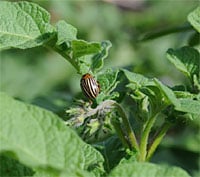ID Those Insects
Yellowing stems? Holes in leaves?

Colorado potato beetles are fairly easy to identify because of their distinctive stripes.
Though the vast majority of the insects in our gardens are harmless — or even beneficial — some of them are definitely pests. A little knowledge about the basic life cycle and feeding habits of these pests will go a long way in helping you recognize and effectively address the problems they can cause. Note: for simplicity's sake, we're considering mites, snails and slugs (which are not true insects) as insect pests.
Sucking insects: Aphids, leafhoppers, and harlequin bugs feed by inserting their long mouth parts into plants and sucking out the juices. As they feed, some of these insects can also transmit plant viruses. Typical signs of sucking damage include an overall weakening of the plant; yellowed, brown or wilted leaves; and a sticky substance or sooty black mold on the leaves (this is a common indicator of aphid activity). Unlike most insect pests, these sucking insects look like adults as soon as they hatch from the egg.
Chewing insects: This group includes caterpillars and beetle larvae, such as the Colorado potato beetle, cabbage worms, and tomato hornworms. These pests can be voracious feeders that chomp down entire leaves and completely defoliate plants. They may also do nothing more than nibble leaf margins or pepper leaves with tiny bites. Most chewing insects go through a complete metamorphosis, from eggs to larvae to pupae to adults, changing appearance at each stage. Different insects cause damage at different points in this cycle, sometimes in more than one stage (the Colorado potato beetle, for example, is destructive as a nymph and as an adult).
In general, insects are easiest to control during the egg stage. Remove the eggs (they're often found on the undersides of leaves) and dispose of them. Many insects reproduce more than once during a season. Keep your eyes open all summer long for adults who may be laying eggs, newly deposited egg clusters, and newly-hatched larvae. Larvae and nymphs can overwinter in the soil or in plant debris, so garden cleanup in the fall is a good means of prevention.
Print this Article:
Get the Dirt
Stay up to date on new articles and advice. Please fill out the information below.
